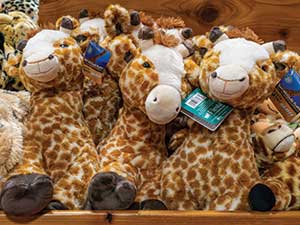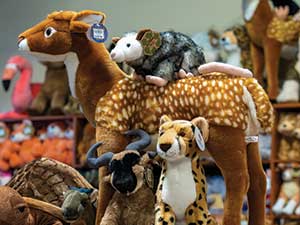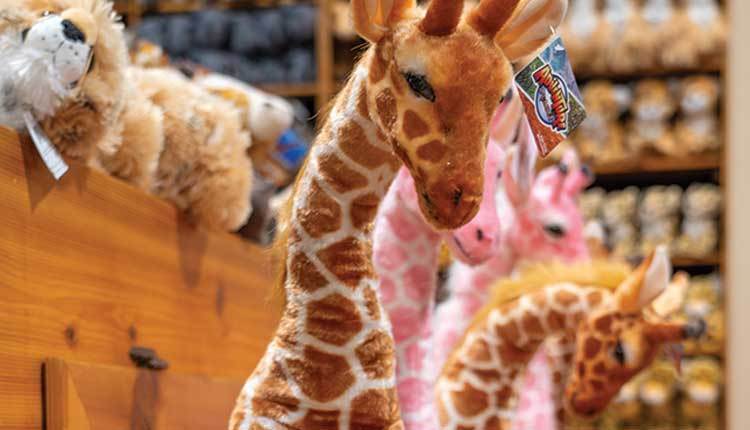Children and adults alike gravitate toward plush souvenirs for the sense of joy, warmth and comfort they bring.It’s easy to assume that most plushies that smile cheerfully at passing customers will find their way into the mouth of a teething toddler or the forceful clutch of an enamored child.
But recent trends suggest that it’s time to rethink that notion. In fact, those who limit their plush offerings to a single section of a store — such as for babies or children — may be doing their inventory a disservice.
“Plushies are truly for all ages,” says Stacey McLaughlin, owner of Stuffed States USA. “Merchandise them throughout the store, peeking out on a shelf of vases, sitting next to a stack of books, leaning against a pillow. Show how they can be used at home.”
McLaughlin notes that her line of stuffies in the shape of U.S. states lend themselves to an older than typical plush demographic — from fourth grade through college. She encourages store owners to look beyond the mainstream to appeal to this age bracket.
“Elevating plush choices is key to attracting teens, tweens and college students with money to spend on vacation,” she points out.
Indeed, the world of plush seems to be expanding to include food items, exotic animals and even social media (emojis, anyone?). To capitalize on this growing trend, buyers and store owners can peruse the latest offerings and figure out how to broaden the market for this collectible to capture a larger demographic that includes teens and adults.
Realism reigns supreme At the Fossil Rim Wildlife Center in Glen Rose, Texas, guests drive through an 1,800-acre nature preserve where rare and endangered species roam free in natural habitats, according to the website. Halfway through the two-hour self-guided tour, the Overlook awaits.
 At the gift shop at Fossil Rim Wildlife Center in Glen Rose, Texas, stuffed giraffes of various sizes tend to be the most popular plush.
Valerie Quindt, manager of retail and cafe services, says the most popular stuffed animal will always be their giraffes of various sizes, and she’s pretty sure she knows why.
“The gift shop is halfway through the park, and it’s right kind of smack dab in the middle of the giraffe pasture,” Quindt explains. “People see the giraffes and then come up to the store and they’re just on a giraffe high.”
However, she notes that different species, such as armadillos and opossums are catching the gaze of teens lately.
“I had a lot of teenagers buy these opossums and I don’t really know why,” she admits. “Their younger siblings are getting the giraffes and they’re like, ‘I want the opossum.’”
After some contemplation, Quindt decides the attraction of the opossum plushies lies in their uniqueness.
“The more realistic it looks, the more adults seem to really enjoy it,” she says. “And teenagers as well, which I am surprised to learn.”
She recently picked up a new line of bugs and insects including tarantulas, bumblebees, ladybugs and a praying mantis from The Petting Zoo and has a hunch they’re going to be great sellers.
As for the best way to display these souvenirs, Quindt says she has the most success starting on the floor and working her way up.
“I have standing giraffes and they’re the perfect size for a toddler to hook it around their arm. And then of course they have a very hard time letting the giraffe go,” she explains. “It’s hard for parents to say, ‘Oh, maybe we’ll get that later’ so putting it on the kids’ level, where they can see it and interact with it a little bit more definitely helps.”
Eye level is buy level While most recommend putting plush at eye level for children, animals at The Ark Encounter gift shop stand at attention in two-by-two formation higher up on display walls to catch the attention of adults, says Jennifer Napier, retail director for the Williamstown, Kentucky, gift shop.
“We keep an eye level with the kids. That’s the reason we have things on the floor,” she explains. “It goes up to the middle and then you go up higher to the more expensive things and it’s a little bit more adult-minded as you go up.”
She adds that size not only diversifies offerings but lends an opportunity for different price points for various demographics.
“Most people don’t realize adults buy plush and young people buy plush, so we try to have something hits all the age groups and the demographics for that,” she says.
 Fossil Rim Wildlife Center’s plush offerings cover the gamut, and the more realistic the more popular, like the opossum.
With so many nooks and crannies to fill, Napier sources from a multitude of suppliers, including Douglas Cuddle Toys, K&M International, The Petting Zoo, Nature Planet, Cardinal Designs and Aurora World.
She adds the key to success lies in making shelves deep enough to display plush attractively and grouping them appropriately by demographic so that guests can just grab and go.
“We try to keep the larger, more expensive ones grouped in two by two to give that demographic a nice visual for the price point and then the other ones, the smaller ones, we display more in bulk because we sell more of those,” she notes.
All the rage And just where are wholesalers finding success and inspiration for plush for adults and teens these days?
Steve Wampold, founder of the Punchkins brand that is known for using plush as a “medium to tell jokes and relate sentiments that are personally relatable,” says they are cultivating the catchphrases of today’s social world.
“We’re finding more and more success designing products that draw inspiration from internet and social media trends,” he says. “Memes and contemporary expressions have had the best traction.”
But resting plush on a shelf by itself won’t do the trick. Wampold implores retailers to get creative with merchandising and to set the tone by arranging them by themes to help clarify the intended audience.
“Because our products complement so many other fun products, we find many retailers mixing us into their themed gift areas where multiple types of products fit a theme for a particular age and demographic,” he explains.
Meanwhile, Aurora World is cashing in on its most successful line ever with Palm Pals, which debuted in 2020, says Imtiaz Hasan, director of marketing. The “wee-sized plushies” come in a variety of collections, such as food items, animals and sports motifs, just waiting to “party” with all of their friends, Hasan explains.
The phenomenon began as an idea to launch 5-inch plush friends for children ages 5-12. However, once social media caught wind of it, they took on a life of their own with the Palm Pals hashtag garnering 26 million views, Hasan says.
“They have become a really big social media frenzy, actually. So, if you see Instagram, TikTok or YouTube shorts, you will see a lot of unboxing videos, because we have set out to collaborate with some influencers,” Hasan says.
More noteworthy, he says, is the age of the collectors, which range between 14 and 34 years old, with 80% being females.
Coral Reynolds, president of Fiesta Toy, agrees that consumers seem to be gravitating toward more unique items and animals being influenced by social media.
“The axolotl can be found everywhere now,” she points out. “In 2024, we saw a huge demand for the capybara, and we are on the search for the next big trend!”
No matter which collection a retailer chooses, one can never be too sure which one is going to be all the rage next. However, Reynolds encourages having something for everyone because plush shouldn’t be limited to children. In fact, trends suggest stuffies tend to take on a life of their own once they hit the shelves for public consumption.
“With plush, I think it defies ages and generations; plush is a feeling and brings people comfort,” Reynolds notes. “Offering a wide variety of plush and different textiles helps. Where someone may look at one item and try to pigeonhole it to an age range, once it’s in the market, it can defy that.”
Before you know it, all the plush that you lovingly arranged just might come off the shelf into the arms of a gum-chewing teenager or an obsessed adult collector. Case in point: look at the axolotl. No one saw that coming.
|



